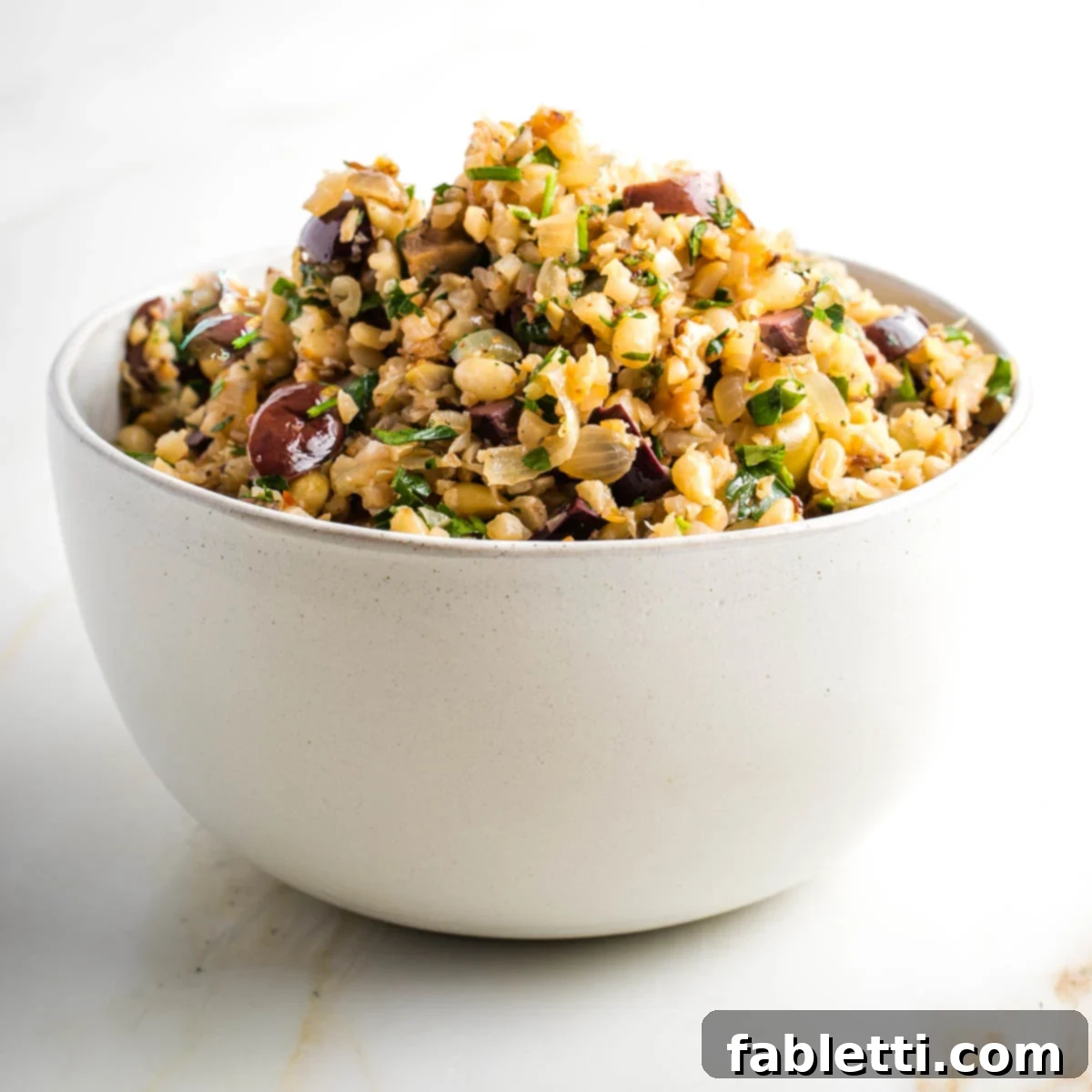Unlock a world of vibrant flavors and wholesome goodness with this incredible recipe for **Vegan Mediterranean Cauliflower Rice**. This dish isn’t just a side; it’s a celebration of fresh, nutrient-dense ingredients, meticulously blended to create a satisfying and utterly delicious experience. Perfect for those embracing a healthy lifestyle, this low-carb, plant-based meal features tender riced cauliflower, briny olives, crunchy pine nuts, and aromatic fresh herbs, all brought to life with a zesty lemon finish. Best of all, it comes together in under 30 minutes, making it an ideal choice for a quick weeknight dinner or a light, energizing lunch.

Say goodbye to bland, uninspired cauliflower rice! This Mediterranean version transforms a simple vegetable into a culinary delight, bursting with the authentic tastes of the Mediterranean coast. If you’re seeking quick, healthy meal options, or a versatile side dish that complements almost any main course, your search ends here. This recipe is not only easy to make but also incredibly versatile, fitting seamlessly into gluten-free, low-carb, and vegan diets.
Why You’ll Fall in Love with This Mediterranean Cauliflower Rice
This dish stands out for several compelling reasons, making it a staple in any healthy kitchen:
- Explosion of Fresh Flavors: The combination of savory olives, nutty pine nuts, bright lemon, and fragrant parsley creates a harmonious symphony of tastes that awakens the palate. It’s a refreshing departure from typical vegetable side dishes.
- Incredibly Quick & Easy: Designed for busy lifestyles, this recipe requires minimal preparation and cooks in less than 30 minutes. It’s the perfect solution for getting a healthy and satisfying meal on the table without fuss.
- Packed with Nutrients: Cauliflower is a cruciferous powerhouse, rich in vitamins C and K, folate, and fiber. Combined with the healthy fats from olives and pine nuts, and the antioxidants from fresh herbs, this dish is a nutritional goldmine.
- Diet-Friendly: Naturally low in carbohydrates, gluten-free, and entirely vegan, this recipe caters to a wide range of dietary preferences and needs. It’s an excellent way to enjoy a “rice” dish without the grains.
- Versatile Serving Options: Whether you serve it as a hearty side dish alongside grilled vegetables or plant-based proteins, as a light main course, or even as a flavorful base for a Buddha bowl, its adaptability is unmatched.
The Amazing Benefits of Cauliflower
Cauliflower, often hailed as a superfood, is the star of this recipe. This cruciferous vegetable offers an impressive array of health benefits that make it an excellent addition to any diet:
- Low in Calories and Carbs: For those managing weight or following a ketogenic or low-carb diet, cauliflower is an ideal choice, offering bulk and satisfaction without excessive calories or carbohydrates.
- Rich in Vitamins and Minerals: It’s an excellent source of Vitamin C, a powerful antioxidant that supports immune health, and Vitamin K, essential for blood clotting and bone health. It also provides good amounts of folate, potassium, and magnesium.
- High in Fiber: The high fiber content in cauliflower promotes digestive health, aids in satiety, and helps regulate blood sugar levels, contributing to overall well-being.
- Antioxidant Powerhouse: Cauliflower contains various antioxidants, including glucosinolates and isothiocyanates, which are known for their anti-inflammatory properties and potential role in preventing chronic diseases.
- Incredibly Versatile: Its mild flavor and adaptable texture allow it to be transformed into countless dishes, from creamy purees to roasted steaks, and, of course, delicious rice. Beyond riced varieties, you can turn raw cauliflower into a delicious cauliflower salad, roast a whole cauliflower head, or slice it into hearty cauliflower steaks for an impressive vegan main course.
Exploring more seasonal and healthy options? Discover new and exciting ways to enjoy Kosher for Passover Recipes while maintaining a balanced diet with our collection of Healthy Passover Recipes, including numerous Vegetarian and Vegan Recipes for Passover.
Essential Ingredients for Mediterranean Flavor
Crafting this flavorful dish relies on a few key ingredients, each contributing to its distinctive Mediterranean character. Here’s a closer look at what you’ll need and some useful substitutions:

- Cauliflower: The foundation of our “rice.” You have the option to make your own fresh cauliflower rice by pulsing a head of cauliflower in a food processor until it resembles grains of rice. Alternatively, for convenience, you can purchase pre-riced cauliflower from the fresh produce section or frozen cauliflower rice from the freezer aisle of your local grocery store. Cauliflower is a cruciferous vegetable renowned for being low in calories and carbs, yet high in Vitamin C, dietary fiber, potassium, and magnesium, making it a fantastic healthy choice.
- Onion: Essential for building a flavorful aromatic base. Yellow, white, or red onions all work well, each offering a slightly different sweetness and pungency. For variations, consider substituting with leeks, green onions (scallions), or shallots, which provide a milder oniony flavor.
- Garlic: Fresh garlic is paramount for the robust, savory notes in this dish. Mince it finely or use a microplane grater to release its maximum flavor and aroma. If fresh garlic isn’t available, garlic powder can be used in a pinch, but avoid garlic salt to control sodium levels.
- Olives: A cornerstone of Mediterranean cuisine, olives add a wonderful briny, salty depth. They are also an excellent source of iron, fiber, calcium, and Vitamin A, and are rich in antioxidants and heart-healthy unsaturated fats. For a more complex flavor profile and diverse nutritional benefits, use a combination of Kalamata olives (richer, fruitier) and green olives (tangier, often firmer). Ensure they are pitted for ease of eating.
- Pine Nuts: These small, buttery nuts provide a delicate crunch and a distinct, rich flavor that complements the other ingredients beautifully. They are nutrient-dense, offering plant-based protein, essential fatty acids, fiber, antioxidants, vitamins, and minerals. If pine nuts are unavailable or you prefer an alternative, toasted slivered almonds, chopped pistachios, or walnuts make excellent substitutes.
- Lemon: Fresh lemon is crucial for brightening the entire dish, adding a burst of acidity and citrusy aroma. Use both the finely grated lemon zest (where much of the essential oils and intense flavor reside) and the fresh lemon juice for the best possible outcome.
- Fresh Parsley: Fresh herbs are non-negotiable for authentic Mediterranean flavor. Parsley adds a clean, peppery, and slightly bitter note. It’s also packed with powerful health benefits comparable to those of leafy greens, including high levels of Vitamin K and antioxidants. Feel free to experiment with other fresh herbs like dill, cilantro, oregano, basil, or mint, or even a combination, to suit your preference.
- Red Pepper Flakes: These add a subtle hint of warmth and a gentle kick, elevating the overall flavor without overwhelming it. If you prefer no spice at all, simply omit them or substitute with freshly ground black pepper for a mild peppery note.
- Cooking Oil/Broth: A small amount of good quality extra virgin olive oil is traditional in Mediterranean cooking and adds richness. For an oil-free option, you can sauté your aromatics in water or vegetable broth.
Step-by-Step: Crafting Your Flavorful Cauliflower Rice
Creating this delicious Mediterranean cauliflower rice is a straightforward process, especially when you start with already riced cauliflower. If you prefer to make your own from a fresh head of cauliflower, check out my detailed simple cauliflower rice post, which includes a section on how to make cauliflower rice from scratch. For this recipe, we’ll assume your cauliflower is ready to go!
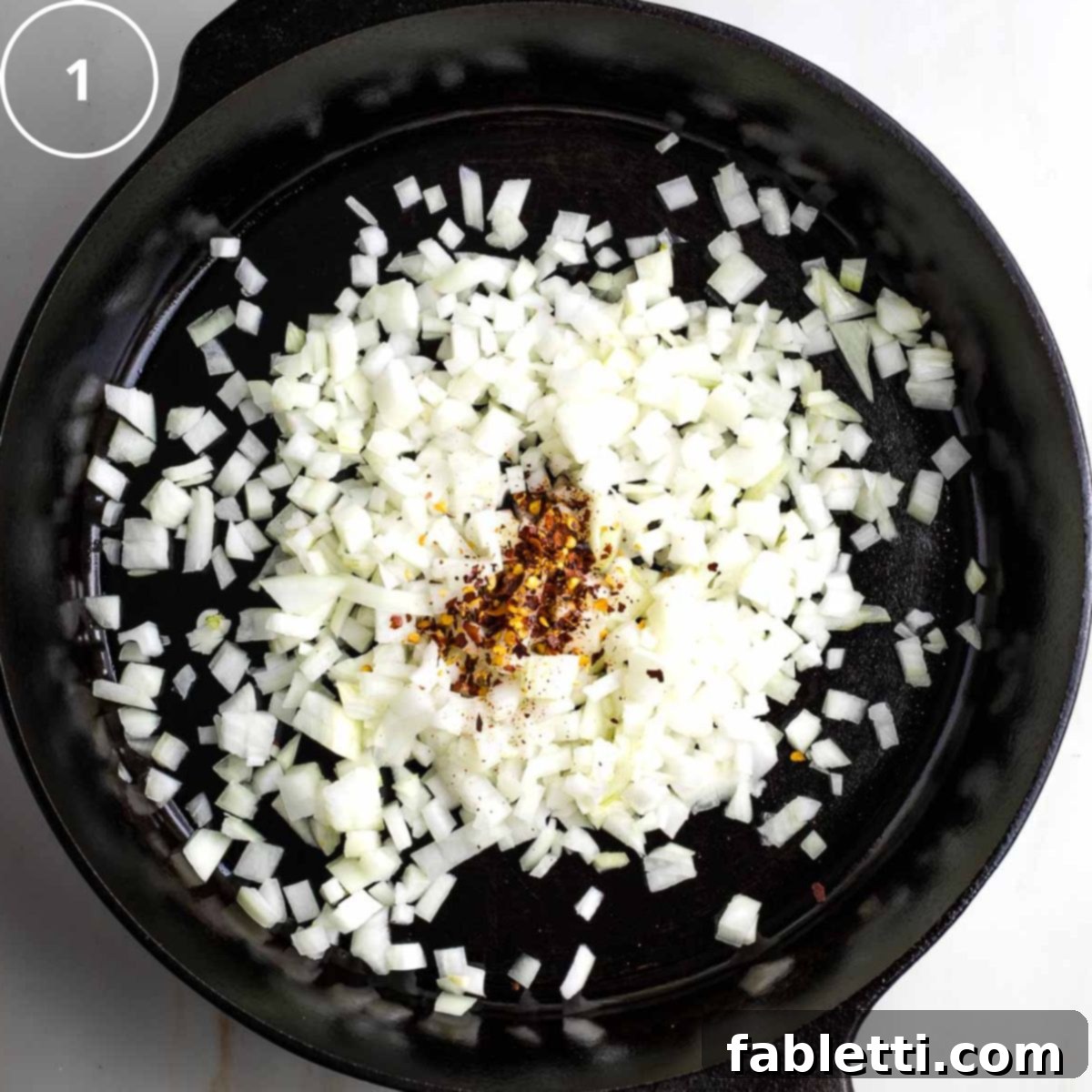
1. Sauté the Aromatics: Heat a large, heavy skillet (a cast iron skillet works wonderfully for even heating and a slight crisp) over medium-high heat. Add your diced onion and red pepper flakes with a tablespoon of extra virgin olive oil, water, or vegetable broth. Sauté until the onions begin to soften and become translucent, releasing their sweet aroma. This step is crucial for building a foundational layer of flavor.

2. Caramelize Onions: Continue cooking the onions over medium-high heat, stirring occasionally, until they are beautifully soft and just beginning to brown. This caramelization adds a deep, savory sweetness that enhances the overall Mediterranean profile of the dish.
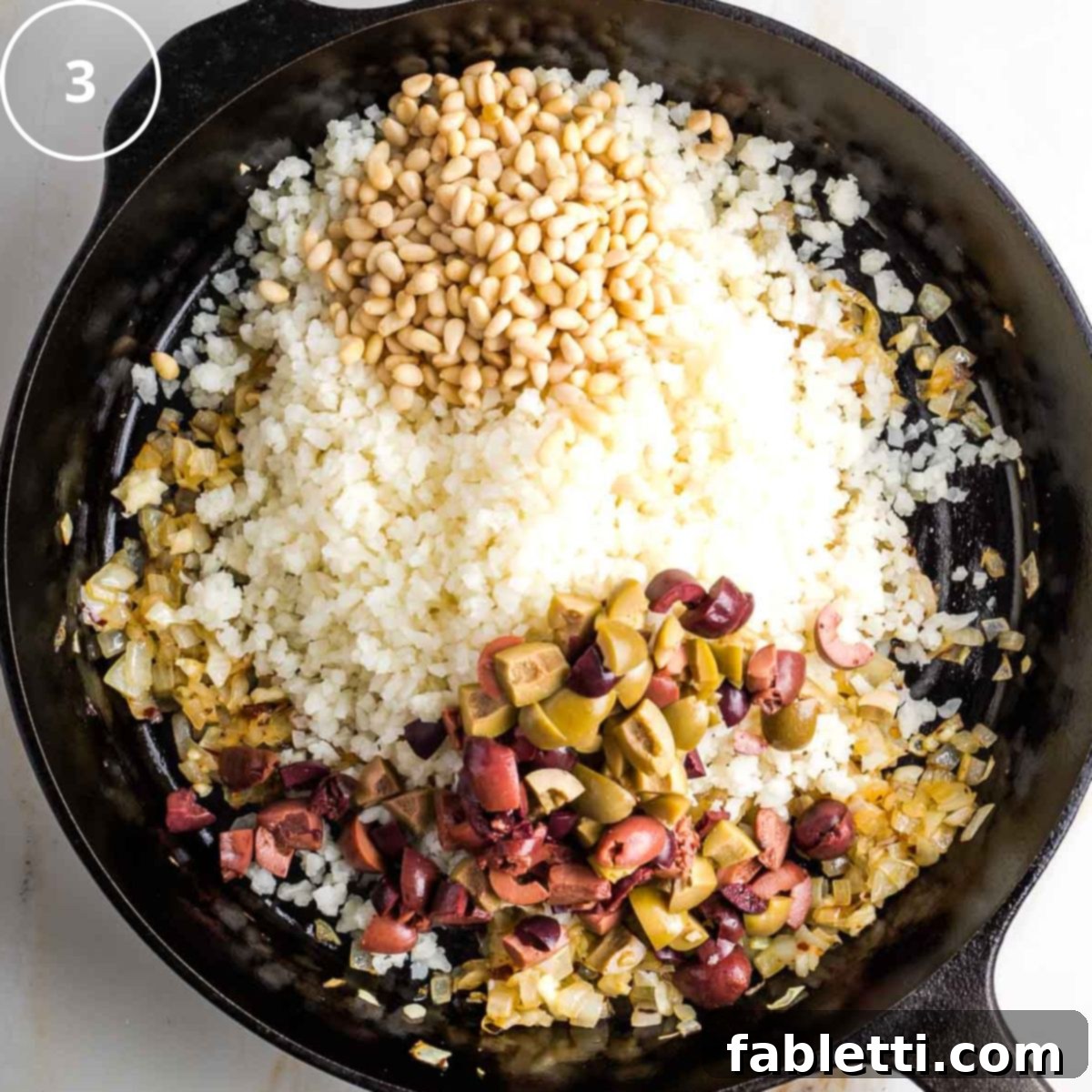
3. Introduce Garlic and Main Ingredients: Add the minced garlic to the skillet and stir constantly for about 30 seconds, until it becomes wonderfully fragrant. Be careful not to burn the garlic, as it can turn bitter. Immediately after, add the riced cauliflower, pitted and diced olives, and pine nuts to the pan. Give everything a good stir to combine all the flavors.
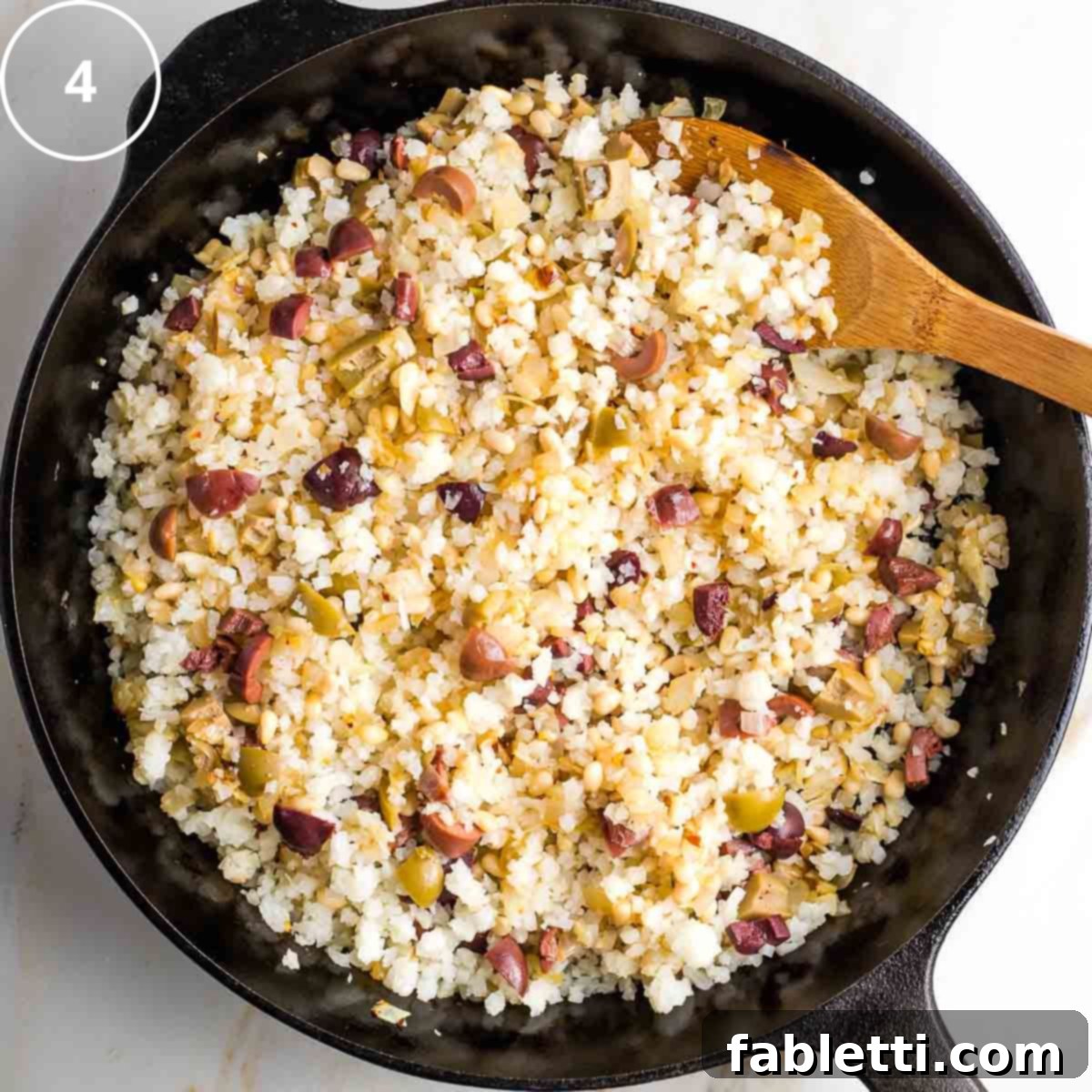
4. Cook Until Tender-Crisp: Continue to cook the mixture over medium heat for approximately 8-10 minutes, stirring occasionally. You want the cauliflower rice to soften to a tender-crisp texture, allowing the flavors to meld beautifully. The exact cooking time may vary depending on the moisture content of your cauliflower and the heat of your stove, so keep an eye on it to prevent overcooking, which can lead to a mushy texture.
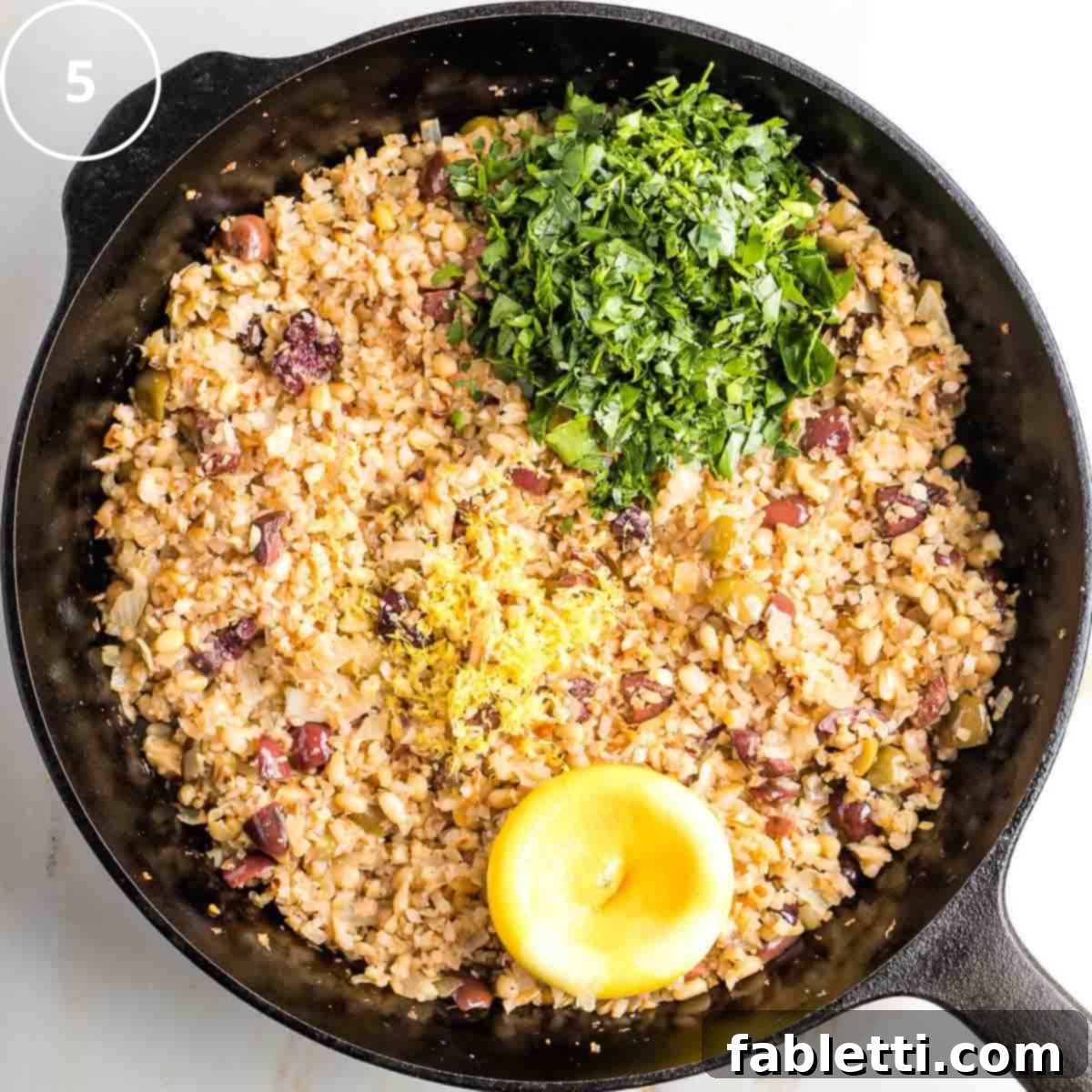
5. Finish with Freshness: Once the cauliflower is cooked to your liking, turn off the heat. Using a microplane, zest the entire lemon directly over the pan, allowing the aromatic oils to infuse the dish. Then, squeeze in all the fresh lemon juice for a bright, tangy lift. Finally, sprinkle in your roughly chopped fresh parsley.
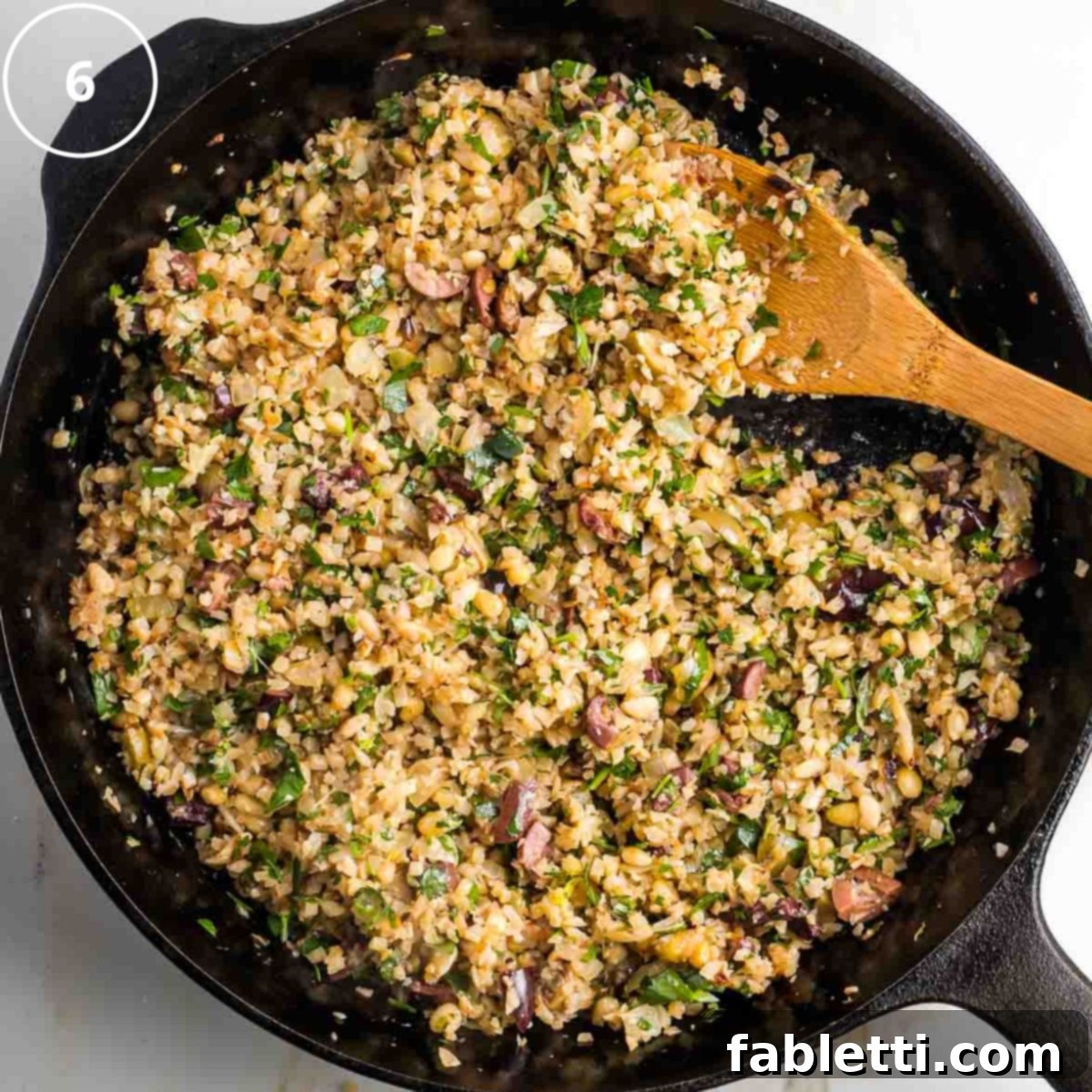
6. Incorporate and Serve: Stir everything gently until the fresh herbs are just wilted and all the Mediterranean flavors are thoroughly mixed together. Taste and adjust seasoning if needed. Serve immediately and enjoy the vibrant taste of the Mediterranean!
Expert Tips for Perfect Mediterranean Cauliflower Rice
Elevate your Mediterranean cauliflower rice from great to extraordinary with these professional tips:

- Amplify Mediterranean Flavor: For an even deeper dive into Mediterranean tastes, consider adding about half a cup of quartered artichoke hearts (canned or jarred, drained well) along with the cauliflower rice. Sundried tomatoes (oil-packed, drained and chopped) also add a lovely depth and sweetness.
- For Crispy Cauliflower Rice: If you enjoy a slightly crispy texture, use a cast iron skillet. Once the cauliflower rice is almost done cooking, resist stirring for the last few minutes and allow it to sit undisturbed. This will encourage a delicious, browned, and crispy bottom layer to form.
- Save Time with Pre-Riced Cauliflower: To make this recipe even faster, take advantage of readily available pre-riced cauliflower. You can find it fresh in the produce section or frozen in the freezer aisle of most grocery stores.
- Save Money and DIY: If you have a food processor, ricing a whole head of cauliflower yourself is often more economical. It’s a simple process that yields fresh, perfectly textured cauliflower rice. Many stores, like Trader Joe’s, also offer competitively priced frozen bagged cauliflower rice.
- Experiment with Blends: Don’t limit yourself to just cauliflower. For added variety and nutrients, try a combination of riced cauliflower with riced broccoli or even grated parsnips. These additions can introduce new textures and subtle flavors.
- Pine Nut Alternatives: If pine nuts are not your favorite or you need a substitution, toasted slivered almonds or chopped pistachios are fantastic alternatives. They provide a similar crunch and healthy fat content.
- Herb Variations: While parsley is classic, feel free to experiment with other fresh herbs. Fresh dill adds a bright, tangy note; mint provides a refreshing coolness; and oregano offers a more pungent, earthy flavor. A mix of herbs can also be delightful.
Storage and Reheating Instructions
This Mediterranean cauliflower rice is excellent for meal prep and stores well, allowing you to enjoy its fresh flavors throughout the week:
- Serving: Mediterranean cauliflower rice tastes best when served warm or at room temperature. It’s a fantastic easy lunch, a satisfying light meal, or a vibrant vegan side dish.
- Storing: Leftovers can be stored in an airtight container in the refrigerator for up to 5-7 days.
- Reheating on the Stove: For best results, reheat in a heavy skillet over medium heat. Stir occasionally until heated through. If you desire a crispy bottom, allow it to sit untouched for a few minutes towards the end of reheating.
- Reheating in the Oven: Spread the cauliflower rice in a single layer on a sheet pan and bake in a preheated 375°F (190°C) oven for about 15 minutes. Alternatively, place it in a casserole dish and bake for approximately 25 minutes until thoroughly heated.
Frequently Asked Questions (FAQs)
Here are some common questions about making and enjoying Mediterranean cauliflower rice:
- Can I use frozen cauliflower rice? Absolutely! Frozen riced cauliflower works perfectly. You can often add it directly to the skillet from frozen, though it might release a bit more moisture. Just ensure you cook it until the excess moisture evaporates and it’s tender-crisp.
- Is this recipe spicy? The recipe calls for ½ teaspoon of red pepper flakes, which provides a mild warmth. If you prefer more heat, feel free to add more. For a completely mild dish, you can omit the red pepper flakes entirely.
- Can I add other vegetables to this dish? Yes, this recipe is very adaptable! Chopped bell peppers (red, yellow, or orange), zucchini, spinach, or cherry tomatoes can be added during the cooking process. Add denser vegetables like bell peppers with the onions, and softer greens like spinach at the very end.
- Is this dish suitable for meal prepping? Yes, it’s an excellent option for meal prepping! It holds up well in the refrigerator for several days and reheats beautifully, making it a convenient and healthy choice for lunches or quick dinners throughout the week.
- Can I make this dish oil-free? Yes, you can easily make it oil-free by sautéing the onions and red pepper flakes in a small amount of vegetable broth or water instead of olive oil. The flavors will still be robust and delicious.
- What can I serve this with? This versatile dish pairs wonderfully with various mains. Try it alongside grilled plant-based chicken or fish, roasted chickpeas, a simple lentil soup, or as a bed for a hearty Buddha bowl topped with hummus and fresh veggies.
More Wholesome Vegan Cauliflower Creations
If you love the versatility and health benefits of cauliflower, you’ll want to explore these other fantastic vegan cauliflower recipes:
- Roasted Cauliflower Hummus Recipe
- Vegan Cauliflower Steak with Chimichurri Sauce
- Creamy Vegan Ricotta Recipe
- Simple Stovetop Cauliflower Rice
Did you enjoy this burst of Mediterranean flavor? Your feedback is incredibly valuable! If you made this delicious recipe, please consider leaving a five-star rating and a comment below. We love seeing your creations, so also share your photos on Instagram by tagging me @dkhealthcoach and using the hashtag #debraklein!
📖 Recipe
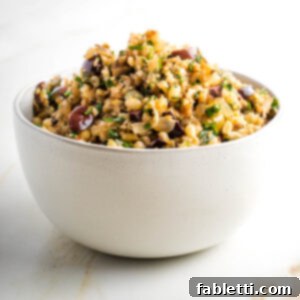
Mediterranean Cauliflower Rice
Pin Recipe
Equipment
- Cast iron skillet
- Wooden Spoon Set
- Microplane
- Olive pitter
Ingredients
- 1 yellow onion diced
- ½ teaspoon red pepper flakes
- 4 cloves garlic minced
- 4 cups riced cauliflower
- ½ cup kalamata olives pitted and diced
- ½ cup pine nuts
- 1 lemon zested and juiced
- ½ cup parsley roughly chopped
Instructions
- Heat a heavy skillet over medium-high heat.
- Sauté the diced onion with crushed red pepper (using water, broth, or olive oil as your normal sauté liquid) over medium heat until softened and starting to brown.
- Add the minced garlic and stir continuously until fragrant, about 30 seconds.
- Stir in the riced cauliflower, diced olives, and pine nuts. Cook, stirring occasionally, for 8-10 minutes, or until the cauliflower is tender-crisp.
- Turn off the heat. Add the roughly chopped parsley. Zest and juice the lemon directly over the pan. Stir until the parsley is just wilted and all ingredients are well incorporated. Serve warm.
Notes
Fresh Parsley: Feel free to substitute with any fresh herb you have or prefer, such as cilantro, oregano, or thyme, as these would all be excellent choices.
Nutrition
Note
The nutrition calculations were done using online tools. To obtain the most accurate representation of the nutritional information in any given recipe, you should calculate the nutritional information with the actual ingredients you used. You are ultimately responsible for ensuring that any nutritional information is accurate, complete and useful.
